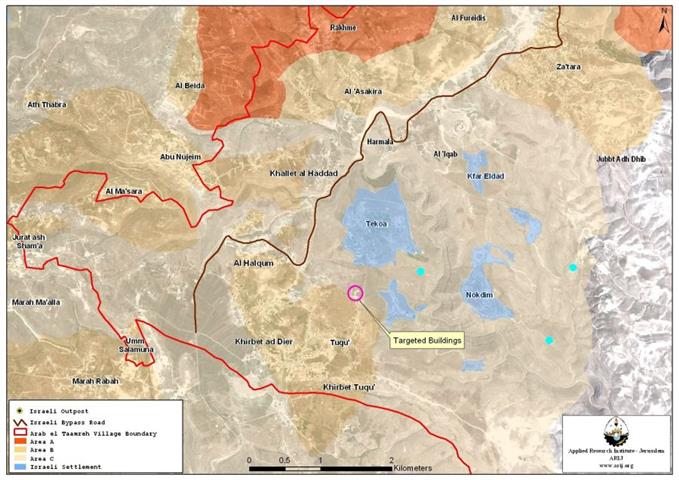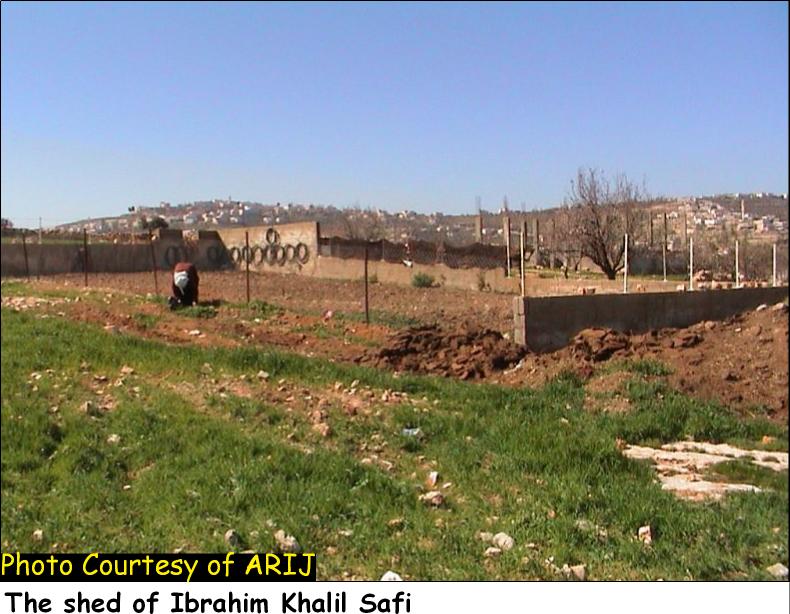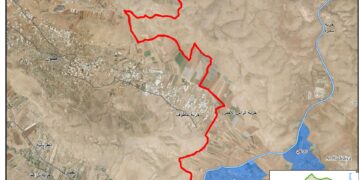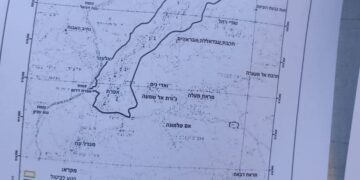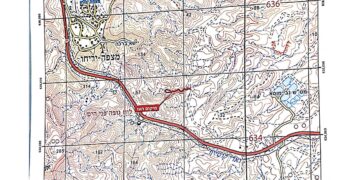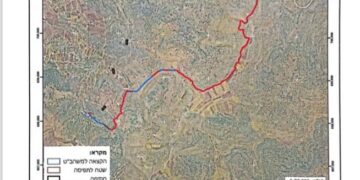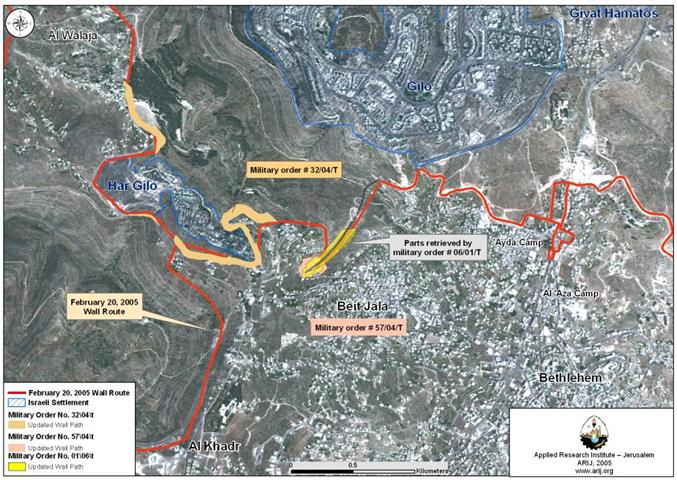Location and population
Teqou is a small village located in the south eastern part of Bethlehem city, and about 12 km away from it. The village rises 850 meters above the sea level. Teqou is surrounded by Al Halqum village from the northwest, Umm Salamuna and Marah Rabah from the west, “Al-Menia” from the south, and from the northeast till the southeast the settlements of Tekoa and Nekodim and their outposts.
In 1961, the village housed a population of approximately 550 persons, in 1967 the number of population reached to 1400, and reached 4100 in 1996 (Palestinian cities and villages). The number of population rose to 6,669 people in 2006 (Projected Mid-Year Population for Bethlehem Governorate by Locality 2004- 2006).
Mr. Raed Hamida the mayor of Tquo in an interview with ARIJ field workers indicated that the village is suffering economically as the unemployment ratio now exceeds 60% due to the Israeli closures, military barriers, and the apartheid Segregation Wall. As for the people who have jobs they work in the following sectors:
-
65% is in the constructions works in Israel
-
20% is in agriculture
-
7% is in the governmental sectors
-
8% in the trade
Teqou is distinguished by hosting many archeological sites such as Khirbet Teqou. Inside the Khirbe there are monuments that go back to the Byzantine, Greek and Mamluke ages, where remnants show that Teqou was an important city then. From its prominent monuments, are what remained from the Greek Church, especially the baptism basin, which is believed to date back to the Greek period before 1750 years.
The second archeological site in the village is Khireton cave.The discoveries showed that beside the cave was the oldest stove in history.
The Israeli Colonization activities in Teqou Village
The main Israeli colonization activity in Teqou village is the Israeli settlement policy which started in 1977, by the construction of 'Teqou' settlement, followed by the construction of “Nekodim” settlement in 1982, reaching to the construction of 'Kfar Eldad' settlement in 1999.In addition to other settlement outposts that are under construction until now. These settlements spread from Teqou’s north eastern part and extend towards its southwest, (See table A+B).
The presence of these settlements and the hostile Israeli exercises hinder expansion, growth and development of the village, and tightens the grip and prevents the villagers from following-up their life naturally. (Table A): Israeli Settlements established on Teqou Village lands
|
|
Israeli settlement |
Date of Establishment |
Area-2004 (dunum) |
Population 2005 |
|
|
1 |
El David (Kfar Eldad) |
1999 |
217 |
650 |
|
|
2 |
Nekodim |
1982 |
397 |
674 |
|
|
3 |
Teqou (including Teqou C,D) |
1977 |
1071 |
1200 |
|
|
|
Total |
|
1685 |
2524 |
|
(Table B): Israeli Outposts established on Lands of Teqou Village
|
|
Closest Mother Settlement |
No. of structures |
Outpost name |
Status |
|
1. |
El David (Kfar Eldad) |
18 |
Ma'ale Rehav’am |
Outpost |
|
2. |
Teqou
|
1 |
Southeast Teqou |
Outpost |
|
3. |
Nekodim |
NA |
Southeast Nekodim |
Outpost |
House Demolition warnings to residents of Tequa Village
On February 15, 2006, the Israeli Occupation Forces notified the owners of three sheds (used for animal husbandry) of their intention to demolish their sheds under the pretext that these sheds were built without licenses and their existence is therefore illegal. The IOF gave the owners three days to demolish the sheds. See Map 1
The first shed is owned by resident Khalil Safi Ahmed Ta'mare and was constructed in year 1993, on a 600 square meters piece of land. The shed was constructed with a cost of NIS 120,000. The shed is the main source of living for the Khalil family which is made up of 16 people. The demolition warning holds number 11321. The owner of the shed has received another 2 demolition notices during the year 2003. See photo 1
The second shed is owned by resident Ibrahim Khalil Safi. The shed was constructed on a piece of land of 500 square meters in year 2002. The shed was constructed with a cost of NIS 10,000 and is the only source of living for the family of 10 people. The owner of the shed said that he received demolition notices twice in year 2003 and this is the third demolition order that he received since he constructed the shed. The demolition order holds number 1319. See photo 2
The third shed was constructed in year 1997, on a land of 200 square meters. The shed was constructed with a cost of NIS 60,000.The shed is the only source of living for the family (8 people). The demolition order holds number 113. The shed’s owner received notices with the destruction twice in year 2003. See photo 3
Another house owned by a local farmer in the village. The house was constructed in the year 2002, with a total cost of 12,000 NIS, on 150 square meters area of land, The shed is still under construction and its owner received an order to demolish it 3 times in the year 2003, but he did not receive a new demolition order this year. Nevertheless, the house is threatened with destruction at any time. See photo 4
Building Licenses in Teqou Village
Building licenses in Teqou village (like the rest of West Bank villages), were obtained from the Israeli 'Civil Administration', from 1967 until Oslo Agreement in 1995. Before 1995, building licenses were very difficult to obtain, and the citizens waited for a long time before getting the license and sometimes fail to get it. After 1995 and the Classification of the West Bank land into A, B, C categories where A are the Lands under the complete Palestinian control, B are the lands were the Palestinian Authority has full control over the civil administration and Israel continues to have overriding responsibility for security, and C are the areas where the Palestinian authority has responsibility for civil life such as health and education while Israel retains full control over security and administration related to territory.
After this Classification of land, Teqou residents started to get building licenses from Teqou municipality, except those whose lands are located within areas classified as 'C' who must continue to get the building license from the Israeli 'Civil Administration' where their permits most often are refused. In the case of the 3 sheds and the house, they will be demolished under the pretext of having no license, (because the land which they build on is classified as 'C').
Conclusion
Israeli restrictions on building in Teqou village, has induced economic and social hardship on the Palestinian villagers. The massive demolition of Teqou houses indicates a systematic plan of ethnic cleansing of the Palestinian land from its Palestinian inhabitants.
Under Forth Geneva Convention, Israel is prohibited from destroying Palestinian property or employing collective punishment .Article 53 reads: 'Any destruction by the Occupying Power of real or personal property belonging individually or collectively to private persons or to the State, or to the public authorities, or to social or corporative organizations, is prohibited, except where such destruction is rendered absolutely necessary by military operations.'
Despite that, Israel continues its massive policy against the Palestinian residents of Teqou, neglecting the international conventions and the decisions of international legitimacy.
References
-
Palestinian Central Bureau of Statistics, (n.d.). Projected mid -year population for bethlehem governorate by locality 2004- 2006 . Retrieved Feb. 20, 2006, from Demographic statistics Web site: http://www.pcbs.gov.ps/Portals/_pcbs/populati/pop10.aspx..
-
Palestinian cities and villages. (n.d.). Retrieved Feb. 20, 2006, from Tqua Web site: http://www.pnic.gov.ps/arabic/palestine/details1.asp?name=295.
Prepared by:
The Applied Research Institute – Jerusalem


